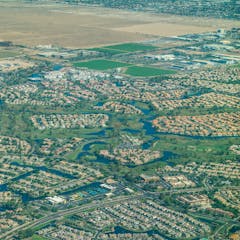
Articles on Water policy
Displaying 1 - 20 of 31 articles

A comprehensive review of research into the economic consequences of controversial water buybacks in the Murray-Darling Basin reveals many studies are of poor quality. Better standards are needed.

With the support of the Greens, there’s a chance the ‘Restoring Our Rivers’ Bill will pass. Will it be enough to put the Murray-Darling Basin Plan back on track?

Arizona is considering a multibillion-dollar desalination project to address its urgent water needs. Three water experts call for a go-slow approach and point to Israel as a role model.

Once again, First Nations in the Murray-Darling Basin have been shortchanged in water reform and shortchanged in the water market. It’s time to listen and actually deliver tangible outcomes.

Pouring these products down the sink causes society-wide problems for the entire sewerage system and the workers who maintain it.

Federal Labor has pledged to deliver the Murray Darling Basin Plan. But a new report casts serious doubt on that promise.

Can one department adequately tackle climate change, energy, the environment and water? It’s unlikely.

A Western scholar proposes allocating water from the Colorado River based on percentages of its actual flow instead of fixed amounts that exceed what’s there – and including tribes this time.

A new book says Australia’s 20-year water trading experiment is sucking hundreds of millions of dollars each year out of the Murray-Darling Basin and directing water away from productive land.

Pipelines, dams, gadgets: does water management really need to be all about control and power? Adopting less masculine ideas and working with nature may be more prudent.

First Nations people have almost no say in how water is used in Australia. The Productivity Commission’s latest report does little to address that.

A major new report from the Productivity Commission calls for an overhaul of Australia’s 17-year-old policy on water.

India’s civil society, which for the past 30 years has been critical of India’s water policies, now has the opportunity to drive the policy recommendations for water management.

Across the NSW portion of the Murray-Darling Basin, Aboriginal people make up almost 10% of the population. Yet they hold a mere 0.2% of all available surface water.

Thirty years since Australia’s water reform project began, it’s clear our efforts have largely failed. We must find another way.

It’s more freshwater than what the population of the Greater Sydney region uses, but finding this out wasn’t easy.

Our study predicts a further 0.5°C increase in temperature by 2041 will halve the current number of farmers in Australia’s Murray-Darling Basin

Cities relied entirely on conserving and recycling water to get through the last big drought. We now have desalination plants, but getting the most out of our water reserves still makes sense.

The Murray-Darling is not just a food bowl, yet the South Australian Royal Commission has found the Murray-Darling Basin Plan is failing its mission to protect the environment as well as irrigators.

Residents of a small Victorian town realised that delicious water can be a curse as well as a blessing, when they lost a legal battle to stop a local farmer shipping groundwater to a nearby bottling plant.
